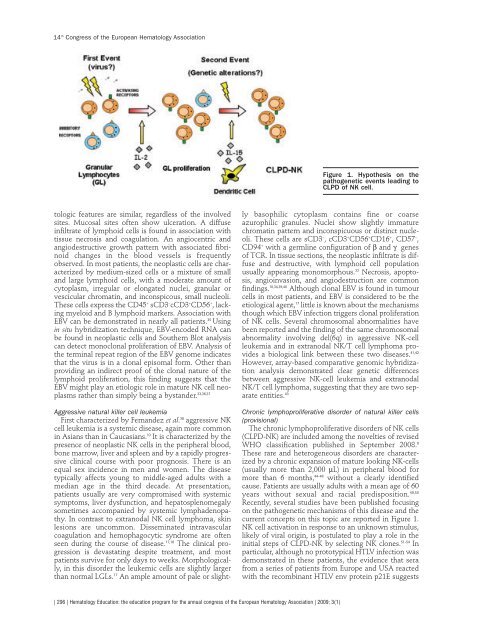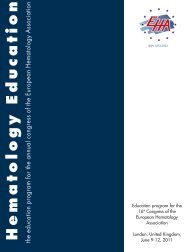hematology education - European Hematology Association
hematology education - European Hematology Association
hematology education - European Hematology Association
Create successful ePaper yourself
Turn your PDF publications into a flip-book with our unique Google optimized e-Paper software.
14 th Congress of the <strong>European</strong> <strong>Hematology</strong> <strong>Association</strong><br />
tologic features are similar, regardless of the involved<br />
sites. Mucosal sites often show ulceration. A diffuse<br />
infiltrate of lymphoid cells is found in association with<br />
tissue necrosis and coagulation. An angiocentric and<br />
angiodestructive growth pattern with associated fibrinoid<br />
changes in the blood vessels is frequently<br />
observed. In most patients, the neoplastic cells are characterized<br />
by medium-sized cells or a mixture of small<br />
and large lymphoid cells, with a moderate amount of<br />
cytoplasm, irregular or elongated nuclei, granular or<br />
vescicular chromatin, and inconspicous, small nucleoli.<br />
These cells express the CD45 + sCD3 – cCD3 + CD56 + , lacking<br />
myeloid and B lymphoid markers. <strong>Association</strong> with<br />
EBV can be demonstrated in nearly all patients. 35 Using<br />
in situ hybridization technique, EBV-encoded RNA can<br />
be found in neoplastic cells and Southern Blot analysis<br />
can detect monoclonal proliferation of EBV. Analysis of<br />
the terminal repeat region of the EBV genome indicates<br />
that the virus is in a clonal episomal form. Other than<br />
providing an indirect proof of the clonal nature of the<br />
lymphoid proliferation, this finding suggests that the<br />
EBV might play an etiologic role in mature NK cell neoplasms<br />
rather than simply being a bystander. 33,36,37<br />
Aggressive natural killer cell leukemia<br />
First characterized by Fernandez et al. 38 aggressive NK<br />
cell leukemia is a systemic disease, again more common<br />
in Asians than in Caucasians. 10 It is characterized by the<br />
presence of neoplastic NK cells in the peripheral blood,<br />
bone marrow, liver and spleen and by a rapidly progressive<br />
clinical course with poor prognosis. There is an<br />
equal sex incidence in men and women. The disease<br />
typically affects young to middle-aged adults with a<br />
median age in the third decade. At presentation,<br />
patients usually are very compromised with systemic<br />
symptoms, liver dysfunction, and hepatosplenomegaly<br />
sometimes accompanied by systemic lymphadenopathy.<br />
In contrast to extranodal NK cell lymphoma, skin<br />
lesions are uncommon. Disseminated intravascular<br />
coagulation and hemophagocytic syndrome are often<br />
seen during the course of disease. 17,18 The clinical progression<br />
is devastating despite treatment, and most<br />
patients survive for only days to weeks. Morphologically,<br />
in this disorder the leukemic cells are slightly larger<br />
than normal LGLs. 17 An ample amount of pale or slight-<br />
ly basophilic cytoplasm contains fine or coarse<br />
azurophilic granules. Nuclei show slightly immature<br />
chromatin pattern and inconspicuous or distinct nucleoli.<br />
These cells are sCD3 – , cCD3 + CD56 + CD16 + , CD57 – ,<br />
CD94 + with a germline configuration of β and γ genes<br />
of TCR. In tissue sections, the neoplastic infiltrate is diffuse<br />
and destructive, with lymphoid cell population<br />
usually appearing monomorphous. 33 Necrosis, apoptosis,<br />
angioinvasion, and angiodestruction are common<br />
findings. 10,34,39,40 Although clonal EBV is found in tumour<br />
cells in most patients, and EBV is considered to be the<br />
etiological agent, 17 little is known about the mechanisms<br />
though which EBV infection triggers clonal proliferation<br />
of NK cells. Several chromosomal abnormalities have<br />
been reported and the finding of the same chromosomal<br />
abnormality involving del(6q) in aggressive NK-cell<br />
leukemia and in extranodal NK/T cell lymphoma provides<br />
a biological link between these two diseases. 41,42<br />
However, array-based comparative genomic hybridization<br />
analysis demonstrated clear genetic differences<br />
between aggressive NK-cell leukemia and extranodal<br />
NK/T cell lymphoma, suggesting that they are two separate<br />
entities. 43<br />
Chronic lymphoproliferative disorder of natural killer cells<br />
(provisional)<br />
The chronic lymphoproliferative disorders of NK cells<br />
(CLPD-NK) are included among the novelties of revised<br />
WHO classification published in September 2008. 9<br />
These rare and heterogeneous disorders are characterized<br />
by a chronic expansion of mature looking NK-cells<br />
(usually more than 2,000 µL) in peripheral blood for<br />
more than 6 months, 44-48 without a clearly identified<br />
cause. Patients are usually adults with a mean age of 60<br />
years without sexual and racial predisposition. 49,50<br />
Recently, several studies have been published focusing<br />
on the pathogenetic mechanisms of this disease and the<br />
current concepts on this topic are reported in Figure 1.<br />
NK cell activation in response to an unknown stimulus,<br />
likely of viral origin, is postulated to play a role in the<br />
initial steps of CLPD-NK by selecting NK clones. 51-54 In<br />
particular, although no prototypical HTLV infection was<br />
demonstrated in these patients, the evidence that sera<br />
from a series of patients from Europe and USA reacted<br />
with the recombinant HTLV env protein p21E suggests<br />
| 296 | <strong>Hematology</strong> Education: the <strong>education</strong> program for the annual congress of the <strong>European</strong> <strong>Hematology</strong> <strong>Association</strong> | 2009; 3(1)<br />
Figure 1. Hypothesis on the<br />
pathogenetic events leading to<br />
CLPD of NK cell.












